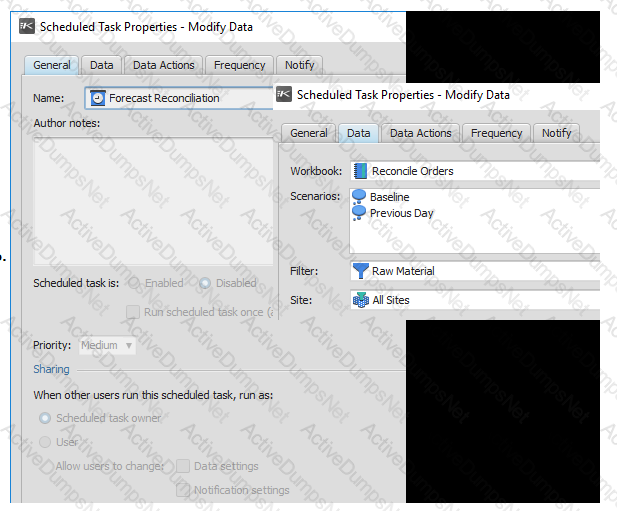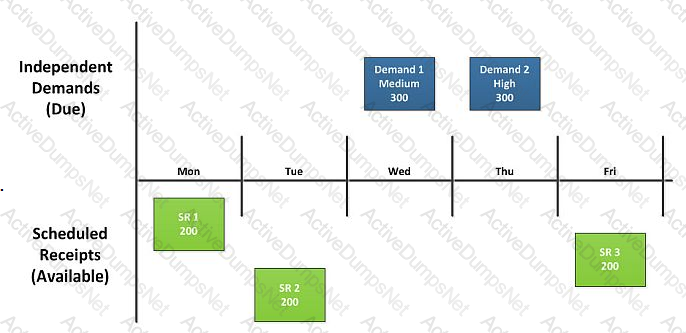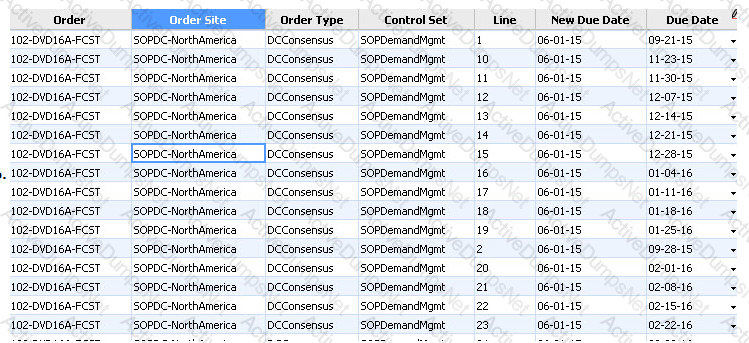Kinaxis KX3-003 Certified RapidResponse Author Level 3 Exam Exam Practice Test
Certified RapidResponse Author Level 3 Exam Questions and Answers
You have a worksheet based on the Part table. You want to know the total number of unique customers that have orders for each part.
Which expression accomplishes this task?
You need to create a workbook to allow users to manage their demand forecast by product, customer region, and distribution site. You also want to simplify user controls and use hierarchies to allow each user to make several selections in the same hierarchy.
In this situation, which two actions should you take? (Choose two.)
Choose 2 answers
You are asked to improve the performance of a worksheet based on the WhereConsumedForDemand table. You notice there is no filter control selected.
Which type of filter will improve performance?

You shared your scheduled task, shown in the graphic, with a set of users who do not have access to all the resources used in the task.
In this situation, which statement is true?
You have defined a new namespace, TRM. You now want to define a new table that has a key reference field to the Mfg::ABCCode table. However, in the Add Input Field dialog,ABCCode does not appear.
What should you do to create the ABCCode key reference?

Referring to the Supply and Demands shown in the graphic, and taking priorities into consideration, which scheduled receipts (SR) will be allotted to Demand 2?
You are asked to transform PlannedOrder data into new ScheduledReceipt records, assuming just one PartSource per part and no maximum quantity. You need to filter the PlannedOrder records to ensure you do not try to create any ScheduledReceipt records which already exist. The workbook includes a worksheet, LKPScheduledReceipt, on existing converted ScheduledReceipts and follows Kinaxis best practices.
In this situation, which filter expression will follow KInaixs best practices and provide the best performance to include PlannedOrder records that do not match existing ScheduledReceipt records?

Given the following order policies:
- MultipleQty: 10
- MinimumQty: 15
- MultipleUsage: Use
- MinimumUsage: Use
Referring to the graphic, what are the sizes of the three planned orders A, B, and C?

You want to create a workbook command that will modify the existing records on the worksheet shown in the graphic. You want the records to copy the date value in New Due Date to the DueDate field in each record.
What should you change in the worksheet to create the modify command?
After the most recent planning cycle, a planner asks you why there were no new records in the HistoricalPartKPI table. They expected these records to be written as part of a scheduled automation chain. You must determine if the automation chain has been disabled, but you are not familiar with which automation chain should perform this action. As the first step in identifying the automation chain, you need to search for any of its associated resources.
In this situation, which process would guarantee that you have the correct associated resources of the automation chain?

You have a new demand for 800 units of a product. SourceRule.AllotmentRule for this part is set to OnGoing.
Referring to the graphic, which planned order results will be created to satisfy this demand?

You need to create an expression that displays the number of the calendar week from the beginning of the year, for example, 01 January 2017 to 07 January 2017 = week 1. The calendar is based on a January to December fiscal year. The Calendar table has the values shown in the graphic.
Which expression would display the number of the calendar week?
You have a worksheet based on the IndependentDemand table that includes columns for key fields plus multi-scenario columns for Quantity and EffectiveDemand. You want to highlight the Quantity fields where the value in the comparison scenario is different from the corresponding value in the workbook's baseline scenario. You want your worksheet to be able to highlight differences in several scenarios.
How would you achieve this highlighting?
You are asked to report data based on the ScheduledReceipt table that also displays information from a custom table, WorkOrderInfo. There will be at most one WorkOrderInfo record for any ScheduledReceipt record and WorkOrderInfo will be used often in worksheets reporting ScheduledReceipt data.
Following Kinaxis best practices, what should you do to accomplish this task?
You want to provide a worksheet based on the CRPOperation table to report destination location. There is only one valid stock location per operation. A secondary requirement is to view all valid work centers that feed a given stock location.
Which approach should you use to optimize performance?

You want to define a custom data structure connecting BuyerCode to additional information: Manager, Department, and Floor. A manager might be responsible for more than one department. You expect that users will want to filter this information on combinations of each of those data elements.
Referring to the graphic, which data model structure should you use?
You want to create a composite worksheet using two component worksheets. The group by columns in both worksheets are Part.Name, Part.Site, Order.ID, Order.Site, Order.Type, Order.Type.ControlSet, and Line.
How would you improve performance of the composite worksheet?
You need to create a new custom field to be used for record filtering that will be populated with the salesperson's name. Each order will have a single associated salesperson's name.
Following database design principles and Kinaxis best practices, which action accomplishes this task?
